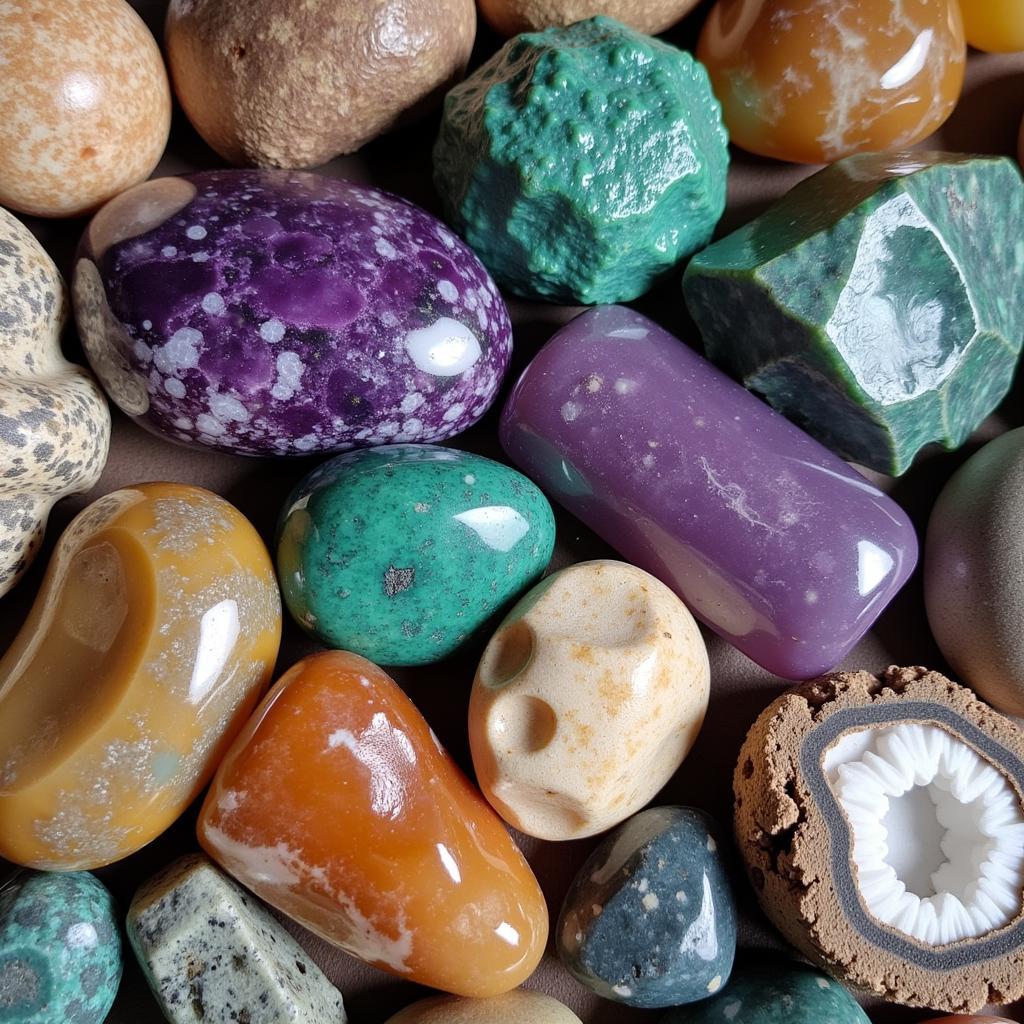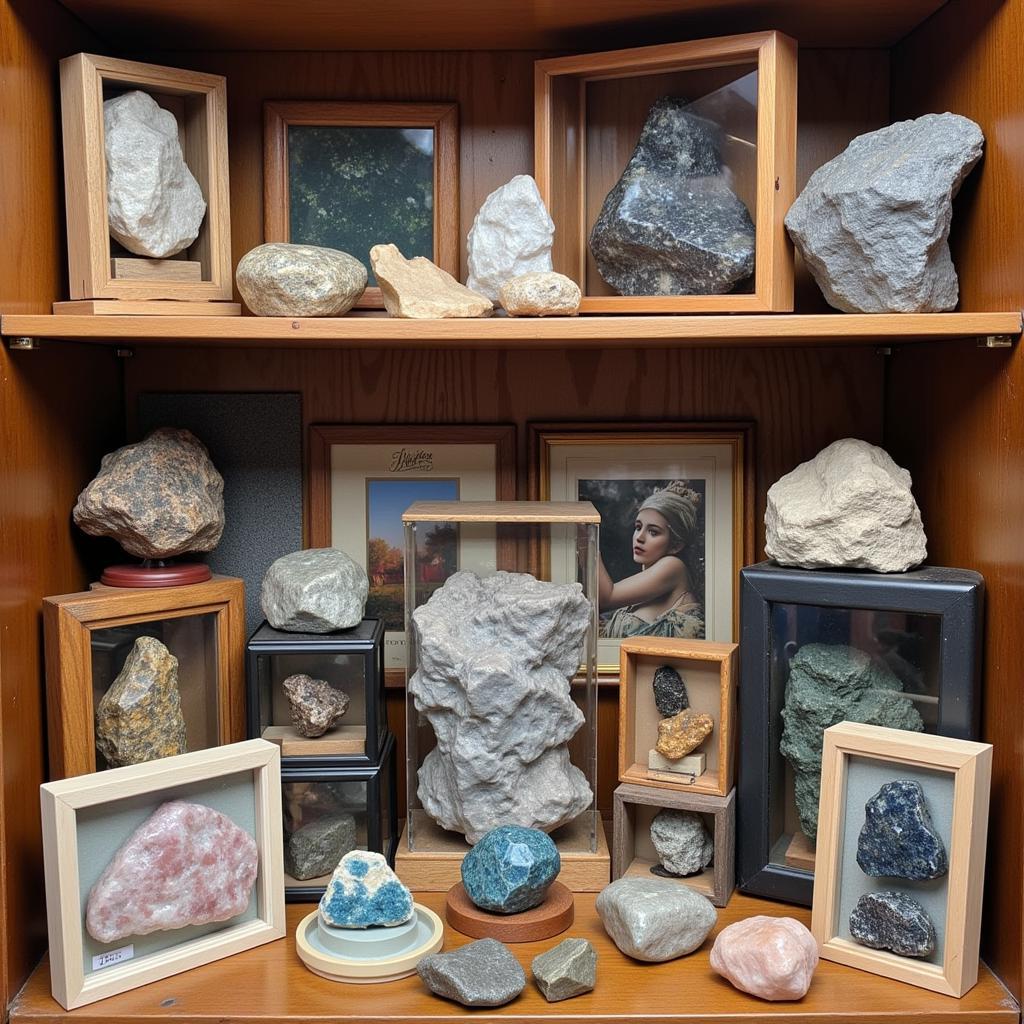Collectable Rocks offer a fascinating glimpse into the Earth’s geological history and provide a tangible connection to the natural world. From vibrant gemstones to unusual formations, the world of collectable rocks is vast and diverse, appealing to both seasoned collectors and curious beginners. This article delves into the captivating world of collectable rocks, exploring their various types, the thrill of the hunt, and the valuable insights they offer.
Unveiling the Diversity of Collectable Rocks
Collectable rocks come in a breathtaking array of shapes, sizes, colors, and textures. Some are prized for their rarity, while others are sought after for their unique aesthetic qualities. Broadly, collectable rocks can be categorized into minerals, rocks, and fossils. Minerals are naturally occurring, solid substances with a specific chemical composition and crystal structure. Rocks, on the other hand, are composed of one or more minerals and can be igneous, sedimentary, or metamorphic. Fossils, the remnants of prehistoric life, provide a window into the Earth’s ancient past. Within these categories, the possibilities are endless. From the shimmering beauty of amethyst to the intriguing patterns of petrified wood, there’s a collectable rock to suit every taste.
 Diverse Collectable Rock Specimens
Diverse Collectable Rock Specimens
Whether you’re captivated by the fiery glow of opals or the intricate details of fossilized shells, collecting rocks offers a unique and rewarding experience. Each specimen tells a story, whispering tales of volcanic eruptions, ancient oceans, and the slow, inexorable forces that shape our planet.
The Thrill of the Hunt: Where to Find Collectable Rocks
Finding your own collectable rocks adds another layer of excitement to the hobby. There are numerous places to embark on your rock-hounding adventures, from beaches and riverbeds to quarries and mines. Researching local geological formations can lead you to promising locations. Joining a rockhounding club or attending gem and mineral shows can also provide valuable insights and opportunities to connect with fellow enthusiasts.
Remember to always obtain permission before collecting rocks on private property and to familiarize yourself with local regulations regarding rock collecting. Respecting the environment and leaving no trace of your presence is essential for sustainable rockhounding.
Understanding the Value of Collectable Rocks
The value of collectable rocks is determined by a variety of factors, including rarity, aesthetic appeal, size, and condition. Some rocks, like rare gemstones, can be quite valuable, while others are prized for their sentimental or scientific significance. Learning to identify and evaluate different types of rocks is a crucial aspect of rock collecting. Resources such as field guides, online forums, and expert appraisals can help you develop your knowledge and understanding.
What Makes a Rock Collectable?
A rock becomes collectable when it possesses qualities that make it desirable to an individual. This could be its beauty, rarity, scientific significance, or even its personal connection to a specific place or time.
How to Care for Your Collectable Rocks
Proper care is essential to preserve the beauty and integrity of your collectable rocks. Cleaning your rocks with a soft brush and water can remove dirt and debris. Storing them in a cool, dry place away from direct sunlight can prevent fading and damage. For delicate specimens, consider using protective cases or displays.
 Displaying and Storing Collectable Rocks
Displaying and Storing Collectable Rocks
The Enduring Appeal of Collectable Rocks
Collectable rocks offer a timeless connection to the natural world. Whether you’re drawn to their beauty, their scientific significance, or the thrill of the hunt, collecting rocks is a rewarding hobby that can be enjoyed by people of all ages. From the smallest pebble to the largest geode, each collectable rock holds a unique story, waiting to be discovered.
FAQ
- What are the most common types of collectable rocks? Common types include quartz, amethyst, agate, jasper, and petrified wood.
- Where can I find information about identifying rocks? Field guides, online forums, and rockhounding clubs are excellent resources.
- How do I clean my collectable rocks? A soft brush and water are usually sufficient. Avoid harsh chemicals.
- What is the best way to store collectable rocks? Store them in a cool, dry place away from direct sunlight.
- Are there any regulations regarding rock collecting? Yes, regulations vary by location. Always obtain permission on private property.
- How can I learn more about the value of my rocks? Consult field guides, online resources, or seek expert appraisals.
- Where can I connect with other rock collectors? Join a rockhounding club or attend gem and mineral shows.
Need further assistance? Contact us at Phone: 0902476650, Email: [email protected] or visit us at 139 Đ. Võ Văn Kiệt, Hoà Long, Bà Rịa, Bà Rịa – Vũng Tàu, Việt Nam. We have a 24/7 customer support team.





